We’re Just Warming Up
INSIDE: INFRASTRUCTURE UPGRADES, PROMISING PROPOSALS, A DOWNTOWN REFRESH AND MORE CCA MEMBER NEWS




INSIDE: INFRASTRUCTURE UPGRADES, PROMISING PROPOSALS, A DOWNTOWN REFRESH AND MORE CCA MEMBER NEWS



I believe that the Hudson Valley is special for so many reasons. As a “lifer” here in the Valley, I stay because I choose to. We have so much here to be thankful for and I could get philosophical and go on and on, but this is a trade publication, so let me stay on point.
As I meet with other association executives from different regions at national conferences, I became aware and appreciative of the labor management relations we have here in the Hudson Valley.
Together we work on economic development issues to entice developers to use our members (both contractor members of our associations, as well as members of our local unions). Our associations and union leadership realize that we are one team and that the competition is made up of unscrupulous fly-by-nights, from out of state, who come and take our jobs. Then they don’t pay New York State taxes or insurances and disappear before NYS can get an investigator or inspector to the jobsite. These cheaters are our competition.
We continue to promote our good work and community involvement of our members. We thank our public officials who focus on the cheating competition that don’t play by the rules and work to protect local businesses and workers.
As a personal aside, I think Orange County District Attorney Dave Hoovler’s efforts to deal with our issues should be a model for every county in our state.
Just as everyone is aware of internet and phone scams, we must continue to raise awareness of the deadbeats within our industry. They affect us all as producers and consumers.
Labor and the associations will continue to protect the opportunities for our members.
All best wishes,
Alan Seidman Alan Seidman Executive Director
Alan Seidman Executive Director
On the Level magazine reaches the people who are building a better Hudson Valley. From contractors and union leaders to developers, policy makers, suppliers, and business owners, if they’re involved in construction they’re reading On the Level


TheQuarterlyAssociationsPublicationof: ConstructionContractors•SheetMetal&RoofingContractors•FabricatorsErectors&ReinforcingContractors
THE OTHER FOUR YEAR DEGREE APPRENTICES LEARN WITHOUT THE DEBT
TheQuarterlyAssociationsPublicationof: ConstructionContractors•SheetMetal&RoofingContractors•FabricatorsErectors&ReinforcingContractors
Construction Contractors Association
Mike Adams — Board President
James McGowan — First Vice President
Joseph Perez — Second Vice President
Josh Ingber — Secretary-Treasurer
Scott Dianis — Immediate Past President
Joseph Barone
Roland Bloomer
Dan Depew
Louis Doro
Joe Jerkoski
Kurt Kaehler
Anthony Perrello, Jr.
Mark Stier
Alfred D. Torreggiani
Charlotte Van Horn
Milestones: Summerbrings Retirements, andAnniversariesNewChallenges

TO ADVERTISE WITH US OR TO LEARN MORE ABOUT OUR SERVICES AND MEMBERSHIP BENEFITS, CONTACT:
Lisa Ramirez, Editor: lramirez@ccahv.com
Millie Rodriquez, Advertising: mrodriguez@ccahv.com
DESIGN AND CREATIVE SERVICES BY FisherMears Associates | FisherMears.com
PRINTING SERVICES BY ColorPage Marketing and Publishing | ColorPageOnline.com
On the Level is the quarterly publication of
THE CCA OF THE HUDSON VALLEY | SERVING THE PEOPLE WHO BUILD BETTER SINCE 1956
845-562-4280

CCAHV.com
330 Meadow Avenue Newburgh, NY 12550
Fabricators, Erectors & Reinforcing Contractors Association

Justin E. Darrow — Chairman
Jake Bidosky — Vice Chairman
Bernie Hillman — Secretary
Daniel Teutul — Treasurer
SMACNA of Southeastern NY
James D’Annibale — President
Steve Mulholland — Vice President
Dominick DiViesti — Treasurer
Mark DiPasquale — Secretary
Louis J. Doro — Immediate Past President
Daniel Harden
Richard K. Berg
Walter “Chip” Greenwood
William Haskel
Dennis LaVopa, Jr.
Association Staff:
Alan Seidman — Executive Director
Lisa Ramirez — Director of Communications and Membership
Millie Rodriguez — Executive Assistant
Vincent Rouhotas — Administrative Assistant


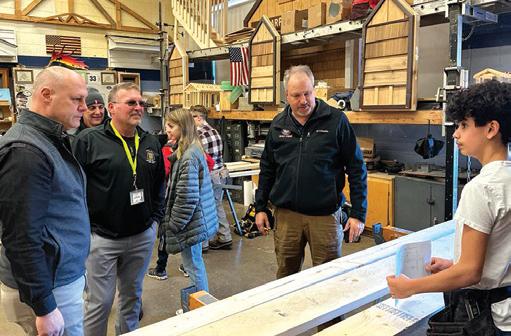

We are pleased to welcome our newest members to the Construction Contractors Association of the Hudson Valley:
After nearly 20 years of serving the Hudson Valley, Jodi Gillespie is the proud broker/owner of Gillespie Real Estate, LLC and continues to serve her clients with professionalism, helping each of their dreams come true. Born and raised in the Town of Newburgh, Jodi earned her master’s degree and has successfully facilitated thousands of residential and commercial real estate transactions, both local and throughout New York. She credits working closely with her clients, and with her diverse network of professionals, as the key to her success. Over 30 years ago Gillespie Real Estate’s founder, Bernadette Gillespie, began her real estate career maintaining a successful track record and reputation for excellence as a staple in Newburgh and its surrounding areas. To learn more call 845-565-7073 or visit www.HudsonValleyRealEstate-NY.com

Minuta Architecture, PLLC, is a full-service architectural firm with offices in New Windsor and Piermont. Minuta Architecture’s mission is to provide architecture for the way people live, work and play through improving the quality of life of individuals, corporations, organizations and communities. A vast array of projects enables Minuta to adapt their trained design philosophies to your project, and they take pride in providing services which are reminiscent of a more sensitive time when a client’s needs came first and the architect was the client’s guide and confidant. The firm has worked with many organizations, local and state governments, large corporations and homeowners. To learn more call 845-565-0055 or visit www.MinutaArchitecture.com.
Montana was established in 1996 and rapidly became a key distributor of electrical, data, transit, telephone, video, fire alarm, security, plumbing supply, and industrial products. They attribute that growth and continued success to the quality products, competitive pricing and prompt service Montana provides. As a Certified Woman Business Enterprise, Montana works on large-scale projects for the Department of Transportation, the MTA, and School Construction Authority, just to name a few. The sales team takes pride in being clients’ go-to-resource for design assistance, installation support, and local inventory, and the management team is always watching the market space, expanding their capacity and capability. With headquarters in Florida, NY and Long Island City, Montana offers timely deliveries to any location. For more information call 646-498-4991 or visit www.MontanaData.com.
Pagones-O’Neill Investigations and Security offers highly skilled security and protection services in Orange, Westchester and Rockland counties and beyond. A highly-respected private investigation and security firm with more than 20 years of experience, Pagones-O’Neill offers a wide range of services, including civil and criminal investigations, full litigation support, municipal investigations, insurance and Worker Compensation investigation, surveillance, under-cover investigations and executive protection details. Their team of professionals includes law enforcement and military personnel with extensive experience. For more information call 845-632-6900 or visit www.PagonesOneill.com












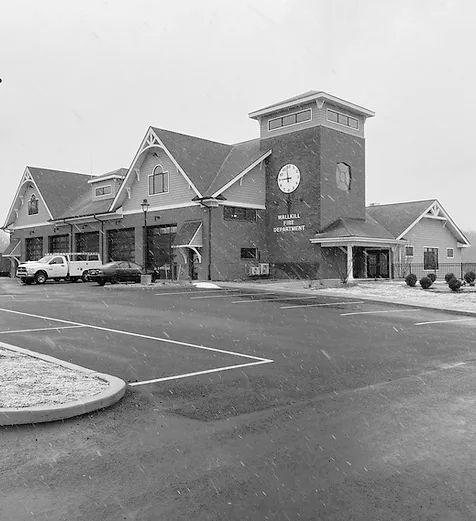



One of the most important things we can build together is a vision for our future. Today, we’re actively preparing for tomorrow by fostering a culture of collaboration, bringing up a new generation of leaders, and training members with the skills for tomorrow’s work. As technology reshapes our field and the world around us, nothing is more important than making sure that our members are equipped to make the most of an ever-changing industry.
THE NORTH ATLANTIC STATES REGIONAL COUNCIL OF CARPENTERS. IT’S TIME TO BUILD.



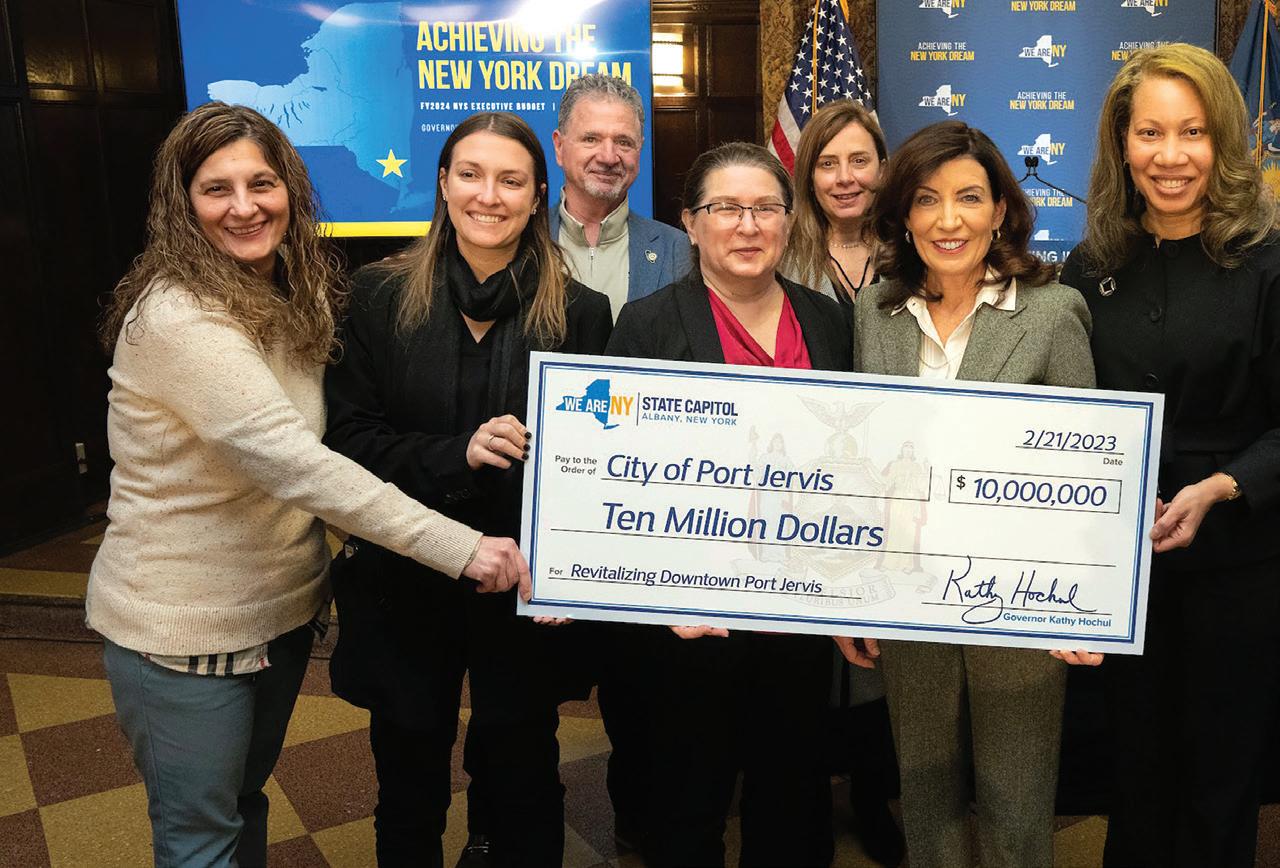
Port Jervis has successfully captured a coveted $10 million Downtown Revitalization Initiative (DRI) grant, an influx of investment to boost the Orange County city on the banks of the Delaware River.
This is Round 6 for the New York State DRI, in which each of the state’s 10 economic redevelopment regions were awarded $10 million, for a total of $100 million to help communities enhance their downtowns and bolster the local economy. Port Jervis is the Mid-Hudson Region winner.
“With this award, the City of Port Jervis will begin a new chapter toward revitalizing its downtown and growing its local economy as a scenic destination for community members and visitors alike,” Governor Kathy Hochul said.
DRI is part of New York’s economic policy, aimed at creating vibrant downtown communities that will
attract businesses, create jobs, and foster economic and housing diversity and, in turn, improve the quality of life. Middletown, Kingston, New Rochelle, Peekskill, Haverstraw and Ossining were Mid-Hudson Region winners in the first five DRI rounds.
Said Assemblymember Karl Brabenec, “These are the kinds of forward-thinking investments that make a difference in the lives of New Yorkers, and I’m proud that Port Jervis is receiving these funds and grateful to the state government for partnering with them.”
To apply for the highly-competitive grant, communities must articulate a strategic plan and identify proposed uses for the grant. Those uses need to show “transformative potential and leverage further private and public investments.”
Port Jervis, poised where New Jersey, Pennsylvania and New York meet, boasts a walkable downtown that has enjoyed renewed investment in recent years. The river’s recreational offerings attract visitors from downstate and beyond, and the city’s historic charm and growing array of restaurants, shops and community services were noted in the DRI grant application.
The community seeks to realize its vision by enhancing downtown attractions, adding housing in new and existing buildings, creating safer streets, enhancing multi-modal transportation options and connectivity and improving energy efficiency throughout the community.
“Many have worked extremely hard over the past several years to improve Port Jervis and this is the icing on the cake,” said Port Jervis Mayor Kelly Decker. “Now it is time to once again roll up our sleeves and work to make this gem shine!”
This year, DRI will invest $100 million in 10 new communities, bringing the total DRI state commitment to $700 million. The Round 6 Communities were announced Feb. 21. They are:

• Capital Region: City of Cohoes
• Central New York: Village of Homer
• Finger Lakes: Village of Perry
• Long Island: Huntington Station
• Mid-Hudson: City of Port Jervis
• Mohawk Valley: The Village of Clinton and the Town of Kirkland
• New York City: East Harlem
• North Country: Town of Ticonderoga
• Southern Tier: Village of Johnson City
• Western New York; City of Dunkirk
Created in 2016, the goal of the Downtown Revitalization Initiative is to accelerate and expand downtown revitalization in all 10 regions of New York. The DRI represents an unprecedented “plan-then-act” approach that couples strategic planning with immediate implementation and results in compact, walkable downtowns, which are key to helping New York build its economy and achieve its climate goals by reducing dependence on private vehicles.
In the first five years of the program, the state committed $600 million, investing in 59 downtowns. The DRI is led by the Department of State, in close partnership with Empire State Development, NYS Homes and Community Renewal and New York State Energy Research and Development Authority.
Amazon is seeking to build a 925,000 square foot distribution center/warehouse in the Town of Wawayanda, which, if successful, would become the third Amazon facility in Orange County.

Officials of Scannell Properties, an industrial development company based in Indianapolis, and Amazon appeared before the Orange County Industrial Development Agency Board in mid February seeking financial incentives, including sales and use tax exemption and mortgage recording tax exemption.
The developer has already secured conditional approval from the Wawayanda Planning Board, and says the requested financial incentives are crucial to making the Wawayanda project cost effective.
Other Amazon properties in Orange County include a 1-million-square-foot warehouse in the Town of Montgomery, which opened in 2021, and a smaller one in New Windsor. Amazon is also building a 600,000 square foot distribution center across the Hudson River in the Dutchess County town of East Fishkill.
The proposed $204 million Slate Hill Commerce Center would be built on a 100-acre tract at McBride Road and Hoops Road. The mostly-vacant land was once a sand and gravel mine. Amazon has said the Wawayanda facility would serve as a distribution center for larger orders, such
as furniture, appliances and sporting gear. The Commerce Center would also include some office space.
Scannell has said construction could start as early as 2023’s second quarter and be completed sometime between the third quarter of 2024 and mid-2025.
In all, the project could mean as many as 750 construction jobs and, when complete, would create full-time jobs for about 150 people.
Plans to build in Orange County come even as Amazon cuts jobs and pulls back plans to build in other places across the country. In November, the company announced that thousands of people would be laid off, with most of those cuts made in Amazon’s corporate and technology divisions. Worldwide, Amazon employs 1.5 million fulland part-time workers.
And according to published reports, Amazon has canceled, delayed or completely closed 99 U.S. facilities in 30 states as it readjusts to the online shopping boom triggered by the COVID-19 pandemic.
Scannell Properties is a privately owned, international commercial real estate development firm specializing in build-to-suit and speculative projects for the industrial, office, and multifamily markets. The firm boasts an annual development volume of more than $5 billion.
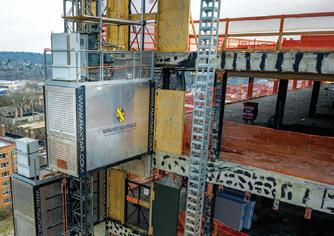



Service Scaffold Company Inc is one of the fastest-growing independent scaffolding companies in the Tri-State Area offering innovative and cost-effective scaffold access and protection solutions to major residential, commercial, civil and industrial customers.
With over 60 years of experience, our talented team has the strength and resources to deliver competitive custom scaffold solutions for any size project. Whether it’s designing and installing scaffold equipment for a large urban building or coming to the aid of a client to erect an emergency sidewalk canopy, we can deliver access and protection.

The “cowboys of the sky” got a presidential shout-out during the President’s State of the Union address when Joe Biden introduced Saria Gwin-Maye, an ironworker and member of Ironworkers Local 44 in Cincinnati.

Gwin-Maye’s local, and other union workers, will soon be at work repairing the 60-year-old Brent Spence Bridge in Covington, Kentucky, part of a major freight route linking Kentucky and Ohio over the Ohio River. Repair to the bridge and the construction of a new one alongside of it, is part of the much-touted Bipartisan Infrastructure Law, a $350 billion federal investment in U.S. highway programs.
Gwin-Maye met the President earlier this year when he visited the region to announce funding for the Brent Spence Bridge repairs.
“While I was there, I met an ironworker named Sara, who is here tonight,” Biden said, during the State of the Union, held the evening of Feb. 7. Gwin-Maye, who was seated in the First Lady’s viewing box, stood to applause as the President continued, “For 30 years, she’s been a proud member of Ironworkers Local 44, known as the ‘cowboys of the sky’ who built the Cincinnati skyline. Sara said she can’t wait to be 10 stories above the Ohio River building that new bridge. That’s pride.”
The new programs under the Bipartisan Infrastructure Law - a five year plan of significant infrastructure repairs and updates - focus on bridge rehabilitation, reducing carbon emissions, strengthening system resilience, connecting communities and improving mobility and access to economic opportunity.
Ironworker Saria Gwin-Maye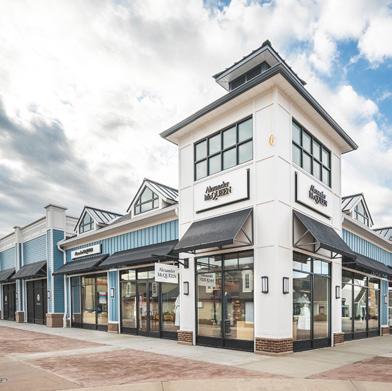
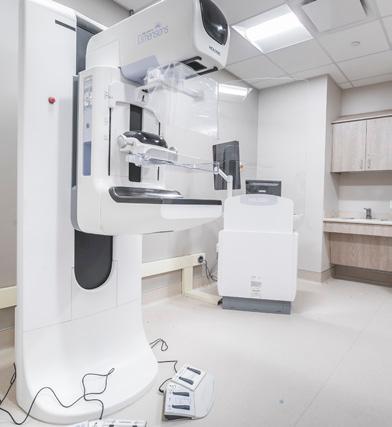



CCA members are among the kindest, most generous people around. Here, we celebrate their good deeds and labors of love:
The Scott’s Corners branch of Walden Savings Bank welcomed the local Girl Scout’s cookie sale, giving the kids a great spot to kick off cookie season.

While the young entrepreneurs were there at the bank they were also treated to a valuable lesson in basic banking, credit and saving money along with expert tips on budgeting and the difference between wants and needs, all why satisfying the Thin Mints cravings for the better part of Montgomery.
The Girl Scout Cookie Program is the largest girl-led entrepreneurial program in the world and has helped generations of Girl Scouts learn life and leadership skills, so grab some while you can.
Super Bowl Sunday was a day of giving for the folks at New Beginnings Window and Door, who turned a classic Super Bowl box pool into an opportunity to raise funds for the Children’s Home of Poughkeepsie.
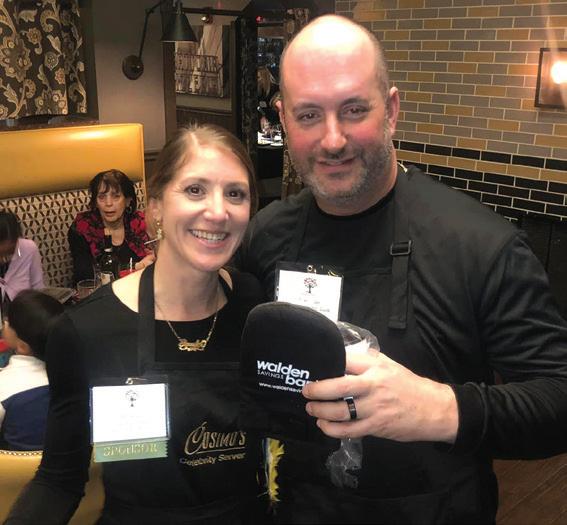
Once all 100 boxes were sold, Marketing and Media Manager Dave Canning pulled the numbers on Facebook Live. Soon after the big game, a $400 check was delivered to the Children’s Home,
Founded in 1847 as the Poughkeepsie Orphan House and Home of the Friendless, the Children’s Home of Poughkeepsie provides community and residential services to at-risk children across New York.
“It was great working with a great organization for an even greater cause,” Canning said.
The folks at The Pike Company were proud participants and a sponsor of this year’s Rochester Junior Builders Exchange Volleyball Tournament, held at the Hot Shots Volleyball club in late February.

This year’s proceeds went to the ACE Mentor Program, a not-for-profit with a mission “to engage, excite and enlighten high school students to pursue careers in architecture, engineering, and construction through mentoring and to support their continued advancement in the industry.” For more information, visit them at www.acementorny.org.
CCA members make up the fabric of our local communities, and Alan Barone of Barone Construction Group, Inc., is a shining example of the contributions they make. For Alan, giving back started at a young age and he’s still going strong.
In 1973, an 18-year-old Alan began coaching with Highland Little League. After nine years he became president of the program and continued to serve the Little League community for two decades.
Alan has also served on the Town of Lloyd Recreation Commission for more than 16 years, including two as chair, and has been a Highland Fire
Department volunteer for the past 40 years, responding to more than 5,000 calls. In 2018, he was elected Highland Fire Department Commissioner and still holds this position.

Then in 2002, Alan was elected to the Highland Central School District Board of Education and has held his seat ever sinceincluding the past 15 years as BOE president - bringing four Capital Projects to fruition, and plans to run for reelection in 2023.
“I enjoy giving back to my community- every one of those positions is non-paying – I think that’s part of life,” Alan says. “You get involved in it, you enjoy it, and you continue to do it.”


The Construction Contractors Association of the Hudson Valley is proud to offer notary public services to our members at no charge. Two members of the CCA’s staff, Executive Assistant Millie Rodriguez and Administrative Assistant Vincent Rouhotas, are commissioned New York State Notary Publics, having successfully completed the required training.
A notary’s duty is to screen the signers of documents for their true identity, their willingness to sign without duress or intimidation, and their awareness of the contents of the document or transaction. Property deeds, wills and powers of attorney are examples of documents that commonly require a Notary.

If you need notary services, give the CCA office a call at 845-562-4280 to let us know you’re coming. Please be sure to bring the documents that need to be signed and a valid photo ID, such as a driver’s license or passport. This notary service is offered exclusively to CCA, SMACNA and FERCA members. CCA headquarters (330 Meadow Ave. Newburgh) is typically open weekdays 8:30 a.m. - 4:30 p.m.
 Millie Rodriguez
Millie Rodriguez


 By Lisa Ramirez, Director of Communications and Membership
By Lisa Ramirez, Director of Communications and Membership
Members of the 2023 Stewart Military Appreciation Picnic Planning Committee have been meeting regularly in recent months, laying the groundwork for the region’s largest event for military members and their families.
Scheduled for Fall 2023, the event is traditionally held every three years at Stewart Air National Guard Base. Like so many events that were canceled as a result of the COVID-19 pandemic, the gathering was scheduled for 2020, canceled and rescheduled for 2021, and once again postponed in 2022.
But the Military Appreciation Picnic — a day of great food, entertainment and family activities — is back on, and thousands of guests are expected to
attend. It is a monumental undertaking, made possible only by the generous donations of many local organizations and individuals.
The Planning Committee has launched a fundraising campaign and is seeking benefactors to help make this year’s Military Appreciation Picnic special, and local and regional not-for-profits, community organizations and businesses have always given their generous support. Volunteers are also needed to set up, clean up, and do everything necessary to ensure that our guests of honor — the enlisted military members, their spouses and their children — enjoy the day and are shown our admiration, respect and appreciation.
We hope you will join us in supporting this event by becoming a Stewart Military Appreciation Picnic Benefactor. There are opportunities to become a Stewart Military Appreciation Picnic Benefactor at several levels, and all benefactors will be recognized at the event.
To learn more about becoming a Picnic Benefactor, to make a donation or for information on how your organization can help, call Organizing Committee Chairperson Alan Seidman at 845-562-4280 or email aseidman@ccahv.com. To donate online, visit https://cfosny.org/our-funds/designated/military-appreciation-day-fund.

A Step-by-Step Guide to a World Wide Web Relaunch
Your website is one of your business’ most powerful tools; it can help define your brand, communicate your message, and differentiate your organization from the competition.
Dean Brady Chief Creative Officer
But like all business assets, websites must be maintained and, sometimes, completely redesigned. Functions become obsolete, platforms change and evolve, designs become stale, and customer expectations shift. In fact, virtually every organization will, at some point, find itself in need of a redesign in order to improve user experience, enhance engagement, update visual appeal, incorporate new features, and, ideally, increase conversions (the rate of site visitors who take a desired action.)
It can be both thrilling and challenging to redesign a website, especially for companies and organizations that rely on them for their primary online presence. Yet it can also be a difficult task that needs to be carefully planned and carried out to prevent costly errors.

At 88 Studio (Eighty8Studio.com) we’ve gathered the essential factors that you must take into account to successfully revamp any business website. These pointers can help you remodel your website successfully and with confidence:
Setting goals is crucial before you begin. What do you hope to accomplish, and what problems do you aim to resolve? Do you want to increase traffic, enhance user experience, or increase conversions? Defining your goals will empower you to make informed decisions and ensure that your new site supports your objectives.
Everything starts with a website audit, which entails assessing the content, design, functionality, and performance of your current website. During this step you’ll discover areas that need improvement, and the audit results will guide your redesign plan. For a thorough website audit, you can utilize a variety of technologies, including Google Analytics and user feedback.
A wireframe is a graphic depiction of a site’s design and functioning. It serves as a blueprint and aids in the organization of the content and design components. When you begin developing your new website, a wireframe will also help you identify potential problems so you can make the required changes.
A crucial component of website design is user experience (UX). Your website needs to be simple to use, visually appealing, and open to all visitors. Focus on establishing a user-friendly interface so that it will direct users to the information they require. Take attention to your website’s functioning overall, mobile friendliness, and loading speed, into account.
It’s also important to ensure that people with disabilities, including those with visual, auditory, motor, or cognitive impairments, can access and use the website effectively and efficiently.
Mobile traffic - people who visit your site using a smartphone or tablet - makes up more than half of all website traffic. Use a responsive design that can adjust to various screen sizes and devices as a result. An example of non-mobile friendly content could be a website that requires users to pinch and zoom excessively to read or interact with the content, making it difficult to use on mobile devices. Your new website will be more user-friendly, increase engagement, and be accessible to all visitors with a responsive design.
The success of your website is directly related to its content - the stories, photos and information you decide to post. Be sure to optimize your content for both consumers and search engines. Employ pertinent keywords, write catchy headlines, and give your visitors useful information. The exposure, traffic, and engagement of your website will all grow thanks to high-quality content.
Before your visitors notice any problems, you can find them and fix them by thoroughly testing your website. Check the functionality, speed, and browser and device compatibility of your website. To assess the effectiveness, make use of tools like PageSpeed Insights and Google’s Mobile-Friendly Test.
Redesigning your website can be daunting, but it’s a worthwhile task, and the end result will be a website that satisfies your company objectives, enhances user experience, and increases engagement by paying attention to these pointers.


We’ve all been rightfully worried about the mounting shortage of carpenters, electricians and other skilled workers, all crucial to the continued growth and economic development. But anyone who witnessed the Region IV Skills USA Competition, hosted by Orange-Ulster BOCES in Goshen, left at least a bit reassured.

During the day-long event, OU-BOCES students competed in a range of contests—ranging from electrical to HVAC and from film production to the culinary arts—exhibiting impressive skills and talents. In all, nearly 2,000 students from more than 70 Mid-Hudson school districts participated in the challenge, demonstrating that, in fact, plenty of students are poised to enter the workforce.
“It’s incredible how talented many of these 17-year-olds are,” said Matthew Ross, Council
 Representative for Carpenters
Representative for Carpenters
Local 279 in Rock Tavern and a SkillsUSA event coordinator and Carpentry judge. “They have a great foundation of skills that set them up to be successful and continue their training once they graduate high school.”
In the Carpenter’s Assistant challenge, students built a birdhouse from a set of plans; in the Carpenter’s challenge, they worked on a roof rafter, laying out stair stringers and roof wall plates. Union carpenters judged their work.

Local officials including Congressman Pat Ryan, state Senators James Skoufis and Michelle Hinchey, Assemblyman Karl Brabenec, Orange County District Attorney David Hoovler, and Orange County Sheriff Paul Arteta were at the event to cheer on students.
SkillsUSA’s mission is to “empower its members to become world-class workers, leaders and responsible citizens.”
The organization serves 331,000 students and instructors annually, including 19,000 instructors who join as professional members.
Local SkillsUSA chapters focus on teamwork, character development through skills, and competition and community service. Each spring, selected students showcase their abilities and compete against other New York State CTE students in their career area.
Skills are categorized in 16 Career Clusters inspired by CTE training programs, including Architecture and Construction, which in turn includes:
• Architectural Drafting
• Building Maintenance
• Cabinetmaking
• Carpentry
• Electrical Construction Wiring
• Heating, Ventilation, Air Conditioning and Refrigeration (HVACR)

• Masonry
• Plumbing
• Sheet Metal
• TeamWorks
• Welding
• Welding Fabrication
• Welding Sculpture
Winners from the Region IV competition advance to compete in the state competition.
The other Career Clusters are: A/V Technology and Communications; Agriculture, Food and Natural Resources; Health Science; Hospitality and Tourism; Human Services; Information Technology; Law, Public Safety, Corrections and Security; Leadership; Manufacturing; Marketing; Science, Technology, Engineering and Mathematics; Transportation Distribution, and Logistics.
“Your dedication to your craft and your skill is impressive,” Orange Ulster Career and Technical Education Director Kathleen Smith said during the award ceremony, which was held at the end of the day. “Some days you win medals and some days you don’t, but what’s really important is that you get up every single day and try.”
While I originally set out to write about interest rates and inventory, research into the housing and commercial real estate markets left me feeling that there are a lot of mixed messages out there, and that’s probably because there are. With so many different ways to measure what’s going on with these markets and so many different indices, I feel a need to take a step back and simplify what I’m seeing.
To start, let’s talk interest rates. The Federal Reserve increased them for the eighth time on February 1 by a quarter point. The fact that it was a lower increase than the past few may signal efforts to rein in inflation are working – which would be good news for real estate and ultimately construction. Maybe. While the Fed doesn’t set mortgage rates, which are influenced more so by 10-year Treasury yields, lenders do try to determine what the Federal
Reserve’s actions mean and that eventually impacts mortgage rates, which have dropped from their high of 7.12 percent last October to 6.3 percent as of Bankrate’s national survey on Feb. 1. (The Mortgage Bankers Association is predicting rates as low as 5 percent by the end of 2023.)
Home prices are no longer soaring upward. In fact, they’re starting to stabilize or even decrease a bit, which you would think would mean a pickup in demand and sales, but there are other factors at play. Inventory for affordable housing is down for the 39th consecutive month and the number of properties for sale are down for the 37th consecutive month, according to a report from the New York State Association of Realtors. Rather than adding to inventory, homebuilders are focusing on getting rid of their existing
 Susan Howell, CPA, Partner RBT CPAs LLP
Susan Howell, CPA, Partner RBT CPAs LLP

inventory (and boosting new home sales) and people who locked in historically low mortgage rates will likely continue holding onto their homes. While single family home starts did increase in December, permits decreased. Then starts decreased in January, sending more mixed messages.
Still, the National Association of Homebuilders (NAHB) national Housing Market Index (HMI) increased for the first time in 13 months in January and again in February. The NAHB predicts this increase in homebuilder sentiment combined with lower mortgage rates will spur permits and new starts for single-family homes, which have fallen to the wayside in favor of multi-family homes
due to the expectation that people would continue to rent versus buy. However, the NAHB anticipates higher vacancy rates and tighter lending conditions may lead to a slowdown in multifamily housing starts this year, while others believe multi-family housing remains attractive to investors especially during an uncertain economy.
Turning to commercial real estate, what the Fed does has a bigger impact. When rates increase, there are corresponding slowdowns in investor activity on the commercial side. The 2023 Dodge Construction Outlook expects total construction
starts to decrease, with retail, warehouse and hotel projects falling dramatically and office and warehouse sectors seeing pullbacks.
There’s still a high volume of unfilled office spaces in big cities, although Moody’s Analytics indicates vacancy rates haven’t dropped below 2019 levels.
Thanks to onshoring, CHIP manufacturing and data centers, U.S. industrial real estate needs are on the rise. E-commerce continues to drive the need for warehouse and industrial space. Neighborhood retail is doing well, but malls are not. While the Dodge
Momentum Index, which measures nonresidential building projects in planning and leads nonresidential construction spending, was down 8.4 percent in January it’s still up 32 percent year over year. It also doesn’t hurt that when interest rates are rising, commercial real estate is seen as a solid investment.
That’s where things stand as of 2:12 PM EST on February 23, 2023. If inflation starts increasing again, the Feds change direction, and/ or mortgage rates start increasing again, the message will likely change once again.


Drywall



Insulation
Carpentry
ACT Ceilings


Doors/Hardware
Millwork


Specialty Construction



 Dan Depew Director of Business Development Holt Construction
Dan Depew Director of Business Development Holt Construction

I recently had the honor of leading a panel hosted by the Orange County Chamber of Commerce. Held at the Galleria at Crystal Run, the program, “Energize Orange County,” included discussion on the changes being made by the governor’s proposal to alter the future of energy dependency.
During the panel it became clear that the construction industry not
only builds the infrastructure, it also depends on it to ensure construction opportunities.
The experience also caused me to reflect on my stance on these issues throughout my career, which has included experience with airports, water, sewer, communication infrastructure, and very often, eclectic infrastructure.
During my years as an elected official I took up the fight against the New York Regional Interconnect (NYRI), which would have delivered power from New York’s Northern Tier and Canada. The community didn’t want it, so neither did I. Maybe I thought that if so many people I respect are against this thing it must be bad. Looking back—this was more than 20 years ago—was that the right path?
I also remember taking a stance on shutting down Entergy’s Indian Point. With Sept. 11 fresh in our minds we all feared the next attack would certainly be at the nuclear facility, and it seemed politicians were ruled by their emotions.
During a 10 year period, we, as a community, stopped transmission projects from delivering hydroelectric power, solar power, and nuclear power, and we even pushed to shut down the power plants that provide the energy on which we desperately depend.
We’re shutting down ways of getting energy here, and at the same time fighting ways to deliver it from other places. And we don’t think there will be consequences?
This all defied logic, it has resulted in uncomfortable outcomes to consumers without solutions for the future. Today we know that we will need to nearly quadruple our transmission lines to reach the state’s energy goals. We are now more then ever dependent on energy supply we don’t have.
The folks at NYRI and Entergy pitched ways to ensure reasonably priced power, and, in some cases, cleaner
energy. But we thought they were just trying to make a buck; our society has trained us to hate corporate America and in some cases we have good reason. Sadly, we are now paying for our short sighted and emotional outbursts that shut down these projects and others.
Now think for a moment about your school taxes, or property taxes in general. There are three ways to balance the cost of running institutions like public school and local government
1. Cut services. No sports or marching band, pay teachers less, fewer parks and police, bad roads and unsafe bridges. Cutting may sound great to taxpayers but trust me, the results kill us for generations in more ways than one.
2. Raise taxes. I hate this too. We can’t keep going to the taxpayer to cover everything, and this answer leaves no check on spending.
3. Grow your commercial tax base.
I like Number 3. But here’s the thing: You can’t grow the commercial tax base without utility infrastructure.
New York State’s climate agenda is the most aggressive climate and clean energy initiative in the nation, calling for an “orderly and just” transition to clean energy that creates jobs and while fostering a green economy.
Enshrined into law through the Climate Leadership and Community Protection Act, New York is on a path to achieve a mandated goal of a zero-emission electricity sector by 2040, including 70 percent renewable energy generation by 2030, and to reach economy-wide carbon neutrality.
The plan builds on investments to ramp-up clean energy including:
• $33 billion in 102 large-scale renewable and transmission projects across the state
• $6.8 billion to reduce building emissions
• $1.8 billion to scale up solar
• $1 billion for clean transportation initiatives
• $1.6 billion in NY Green Bank commitments
Together, the investments are supporting nearly 158,000 jobs in New York’s clean energy sector in 2020.
We have allowed the “Just Say No” or “Not In My Back Yard” approach to not merely halt private infrastructure projects, but also to slow down or stall public ones. This mentality stagnates growth and prevents us from attracting the industries that will keep our children here in the Hudson Valley.
Meanwhile, the places enjoying the commercial growth we want—Texas, Boston, and Virginia—offer very competitive incentives and have the infrastructure in place.
We need to be more like them, at least in this regard. Our county and region have been able to thrive and grow thanks to leaders who made big investments, despite the political ramifications.
I also believe that, in many cases, federal laws once bolstered big thinking. The rules and regulations that supported the development of our railroads similarly supported our revolutionary highway system. These projects are the vital life blood of our success and independence as a nation.
Clearly, these massive projects had shortcomings and created hardships. Things could have been done better, and hopefully lessons have been learned. We cannot turn a blind eye. Yet, can you imagine New York City without the reservoir system? And what would the Town of Neversink - one of the most beautiful places around – be without the environmental protections that were put in place? There were protests, and some wounds remain
Legislation A.9598/S.8648 requires prevailing wage for renewable energy projects one megawatt and larger that involve the procurement of renewable energy credits from a public entity.
New York’s 10 gigawatt roadmap, approved by the PSC in April, expands the NY-Sun initiative into one of the largest distributed solar programs in
unhealed. Meanwhile the NYC reservoir system is among the most successful and celebrated projects in the U.S.
A balance must be found between local public advocacy and overall public benefit, and yes, the harmful impacts of any project must be mitigated to the best of our ability. The truth is eggs get broken when making an omelet. We can’t continue to lean heavier on a power grid that is already near capacity. We can’t wait for a drought to think about the water supply. We need sewer plants built to handle our needs today and future needs. We can’t expect the “good paying jobs” businesses— computer chip factories and pharmaceutical companies —to come here when we’re out of water and sewer capacity, transportation systems are crumbling, and energy supplies are limited and offered at a staggering rate.
True leaders from our past had the vision to make major investments in our utilities and infrastructure, and history proved them genius. However, these visionary projects are now at, or well beyond, capacity.
The next time a utility infrastructure project is proposed we must get involved, write letters, and give our local leaders the support and cover they need to make the important decisions.
We cannot sit back, silent, and let projects die. Think big, think to the future, and together, let’s get the right ones built.
the nation. The public investment to achieve ten gigawatts of solar will spur about $4.4 billion in private investment to bring projects to fruition, for a total of $5.9 billion in investment over the mid- to late-2020s.
This means upwards of 6,000 additional solar jobs will be created across the state.
The importance of an ample and reliable supply of “clean” electrical power was the topic of the panel discussion, “Energize Orange County,” hosted by the Orange County Chamber of Commerce.

Hosted by Dan Depew, the expert panelists were:
• Adam Bosch, Hudson Valley Pattern for Progress
• Andrew Farrell, Orange and Rockland Utilities
• Cory Scofield , Central Hudson
• Adam Boese, The Daylight Savings Company
Transmission Projects
Transmission — bringing clean energy from upstate sources to the local region — is a looming challenge and solutions are needed, and “a lot of money is going to be required,” Corey Scofiel noted.
This is, though, an “opportunity for innovation,” added Adam Bosch.
As electric cars become more prevalent, the need for charging stations will grow. Motorists make travel decisions based on the ability to recharge, so venues, restaurants, wineries and other travel destinations could
benefit if they place stations near their businesses. Charging stations also generate foot traffic. For example, charging stations strategically placed in downtown districts can result in walk-in business for coffee shops and other retailers while motorists charge up.
There will be a demand for sites as projects look to come to Orange County. It will be important to ensure that there is space allocated for various uses, including farmland and solar fields.
As New York transitions away from traditional sources of electricity to cleaner/greener sources, residents should experience health benefits. Asthma, lung cancer and several childhood diseases have been linked to pollution and environmental factors, and the move toward more green energy is expected to help alleviate those issues, Orange and Rockland’s Andrew Farrell said.
The February 9th Orange County Chamber of Commerce
Membership Meeting was held at the Galleria at Crystal Run in the Town of Wallkill.


Walden Savings Bank is committed to helping local businesses by providing a wide array of commercial loan products that will allow you the flexibility to run your business and remain focused on growth. Complex projects, construction or renovation, let Walden Saving Bank simplify the loan process.

Our commercial term loans are designed to assist companies interested in expansion, renovation, long-term working capital, machinery/equipment
and rolling inventory.
We offer:
• Competitive interest rates
• Flexible terms
• Experienced advisors

• Fixed and stable payments
• Loan terms range from 12 to 72 months
William Vacca Vice President Business Development Michael Weimer Vice President Commercial Lender NMLS# 1445647 Greg
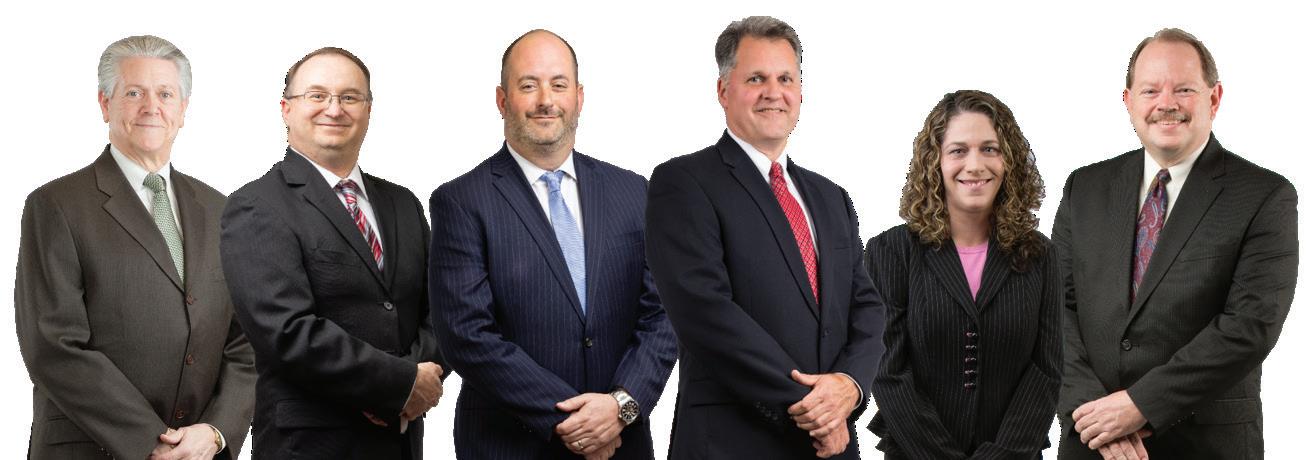 acquisition
acquisition
In the Winter 2022 issue of On The Level, we addressed the question of whether or not it made sense to judge the safety of a contractor by their Workers’ Compensation Insurance experience modification. Both the long and the short answer was no. That article also explained the announced changes to the experience rating formula effective for policies that renewed after October 1, 2022.

With a few months of experience renewing policies under the new formula, we thought it would be a good idea to re-address the issue. The answer is still no; An experience modifier is still a poor way to judge the relative safety practices of a contractor. In some ways, the experience modification system has become more arbitrary under the revised formula.
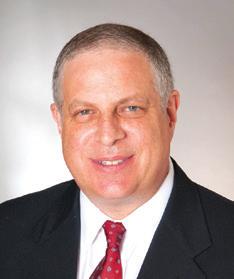
The experience modification formula takes three years of recent loss experience and compares that experience to a predicted amount of expected losses for a given volume of payroll for each class code. Contractors with high payrolls and low losses have favorable modifiers, while contractors with high losses relative to their payroll size see surcharges. The New York Compensation Insurance Rating Board believed that businesses in the top 20 percent in terms of having the best loss experience were not getting rewarded sufficiently by the old formula. Likewise, those businesses in the bottom 20 percent, they believed, were paying too little.
Our experience with the new formula shows that the Rating Board accomplished its stated goal. Businesses with good loss experience now have much higher credits, while poor performers are being punished with much higher insurance costs. But this circumstance has also produced wild swings in insurance pricing for some contractors.
For example, we saw one experience modifier for a $60,000 policy improve by 42 points from a 1.18 to a 0.76 as a particularly bad year dropped out of the rating. Unfortunately for some, this phenomenon worked in both directions. Is it realistic to think that our improving contractor suddenly moved from among the worst performers to among the best performers in terms of safety? Their performance over a longer span of time was much closer to the average contractor of their size.
The problem here is that for most small to medium-size contractors, it is not clear if the occurrence of any one claim is predictive of the likelihood of a subsequent claim.
Workers’ compensation expenses in construction are driven by severity, not frequency — in other words, a small number of large claims account for the majority of loss expenses.
In our group of almost 2,000 contractors, 3 out of 4 members will not have a loss in any given year.

A sample size of three years is simply not credible for determining the safety practices of small to medium-sized contractors. The new experience modification system exaggerates one of the weaknesses of the old system, which was liable to a kind of gambler’s fallacy. The gambler’s fallacy is assuming that a past outcome changes the odds of a future outcome. Just because the coin came up heads a few times in a row, the odds on the next coin flip are still 50/50.
On the other hand, sometimes losses are indicative of poor safety practices, and you don’t have a fair coin. But you can’t tell if that is true simply by looking at one number. Which is why it behooves the industry, especially with the new formula, to move away from using experience modifiers as a shorthand measure of contractor safety.
Any attempt to reduce a process as complex as predicting occupational accidents and disease to a simple mathematical formula is likely to have its issues.


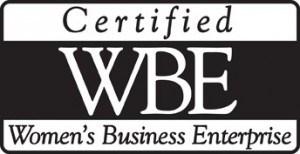


 Nicholas
Founding Partner AffinityBST
Nicholas
Founding Partner AffinityBST
When should you talk to your children about their inheritance?
Sooner than you may think, and those conversations need to transcend the nuts and bolts of financial literacy. Yes, you need to discuss the reality of your wealth, but you also need to empower your heirs with the values they need to manage and use that wealth. There’s no pride in just being given something, but great satisfaction arises from personal accomplishment.
Most families start out instilling values like sharing, helping out, and
earning an allowance. Yet ironically, it seems that the more we grow our wealth, the less we cultivate in our children the attitudes and attributes that were the secret to our success in the first place. This is not a 21stCentury dilemma: “Shirtsleeves to shirtsleeves in three generations” is an old saying – and one we don’t want to prove.
We
Children learn first by watching their parents. If we’re high-powered executives or entrepreneurs, our kids likely see us leave early and get home late, maybe miss their games and

events. They also see big houses, cool cars, the latest toys and tech.
When children experience only money and the stuff it can buy, while the hows and whys of building a meaningful life remain unspoken and invisible, they grow up to feel lazy and entitled.
The speed and accessibility of information today makes it more critical than ever that we instill sound values early on. By the time our kids can read, they’re navigating the internet better than we can. We need to teach them how to discern
Preddice,
Advisors
To set your heirs up for success, craft a practicable plan for passing down life and work skills—attitudes and attributes—as well as wealth.
what’s real and what matters, so they can steer a safe course.
I grew up in scarcity, but my parents taught me priceless lessons: They loved their work; saved more than most people with plenty; and always found a way to give. I got myself through college, sought out opportunities, and ultimately developed a career that my parents could not even imagine.
My children are growing up in wealth, but I also want them to have perseverance, determination, and the kind of never-give-up attitude that enabled my success. I know I am not alone in this. Many wealthy business owners (perhaps you as well) grew up as I did. We want to give our kids the things and experiences we didn’t have growing up, but we also need to give them the values we grew up with. How? There’s no silver bullet, but I can share my own story.
My wife and I deeply believe in the importance of giving back, and we wanted our children to experience the happiness of helping others. Endowing a family foundation made sense to us as both a way of ensuring our legacy and an opportunity for our kids to understand philanthropy in terms of real people. It’s opened up a whole world for them: they’re excited to join us at annual events, but especially when we discuss which projects to fund. They’ve got skin in the game of giving.
Life doesn’t hand us everything we want or need, no matter how deserving we may be. I was looking to open just such a discussion with my nearly 16-year-old son when college tours and applications were on the horizon. It wasn’t a question of what we could afford: I wanted to help him grow into ethical and financial adulthood.
So, I told him I wasn’t going to pay for his college education. He was pretty much speechless. (My wife, however, had a lot to say…) Maybe I should have introduced the topic more gently. Maybe not. I certainly had his full attention as we discussed how he could “get himself” through college.
I wanted to teach him the values of knowledge, giving, and being productive, which I defined as follows:
• Knowledge: Managing money; recognizing the pitfalls of credit cards; and understanding how savings grow, and why they matter
• Giving: Community involvement; philanthropy; and our family foundation
• Productivity: Responsibilities at home; educational achievements; after-school employment
Which values you prioritize is up to you, but as in any business plan, you need to define and measure them.
My son and I agreed that if he successfully met certain milestones during college and in the first decade after graduation I would fully fund his college education. That’s quite an incentive given the average cost of a four-year college is about $250,000.
Some of his goals are strictly delineated: e.g., keeping his grades above 3.5 every semester and saving/investing $50,000 within five years after graduation. Others are more open-ended to encourage him to identify and develop his own purpose and passions: e.g., being meaningfully involved in activities that allow him to help other people; taking a leadership role in a club; serving on a committee for a non-profit organization; and ultimately non-profit board membership.
Together, we review his progress every semester. Of course, he’s highly incentivized to not have to pay me back. And as I’d hoped, he’s proving to be a self-motivated and community-minded individual whom wealth won’t spoil, but will empower.
Nicholas
Preddice, Founding Partnerat
AffinityBST Advisors,helps successful people realize their ambitions for sustaining meaningful lives. Contact him at 973-534-5785 or npreddice@affinitybstadvisors.com.
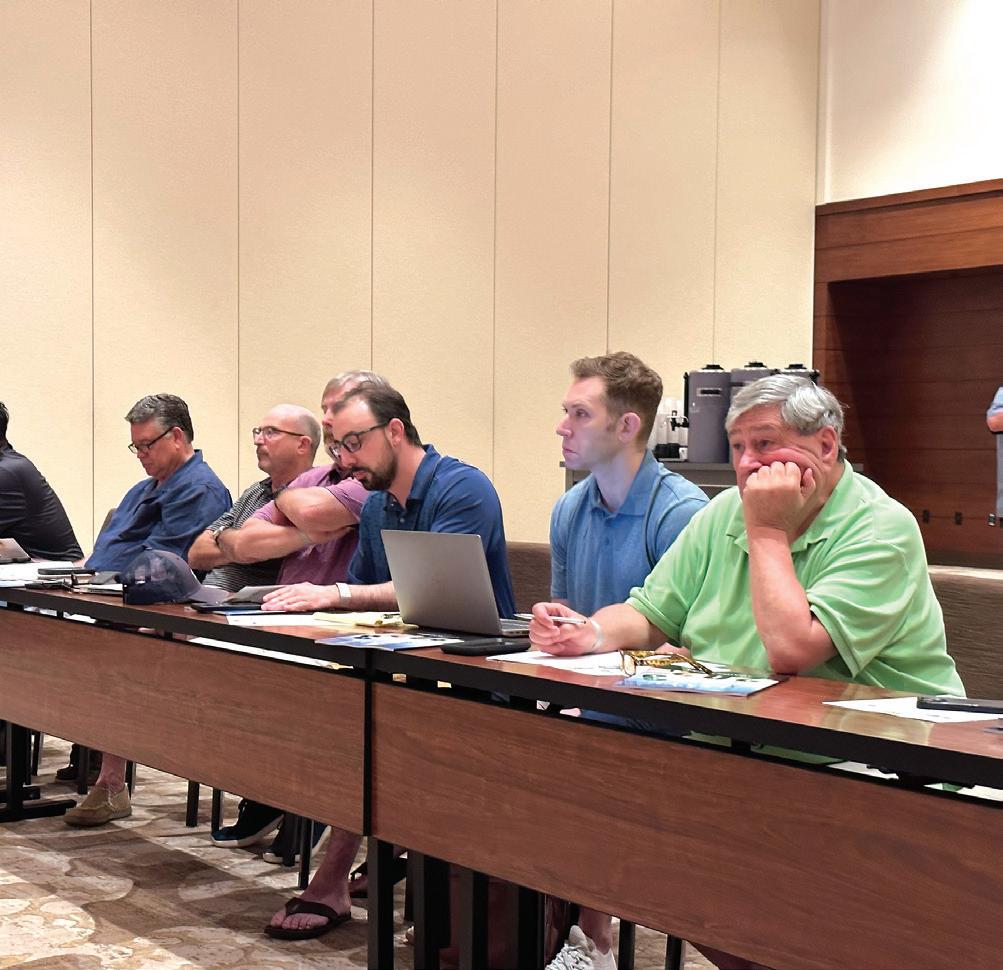

The 13th annual Mid-Hudson Valley Construction Industry Partnership’s Mid-Winter Meeting proved once again to be a crucial gathering for industry experts and influencers. Held March 1-5 at the J.W. Marriott Beach Resort, Marco Island, Florida, the event included panel discussions, educational opportunities, speakers, and valuable opportunities to network and collaborate.
The CCA thanks the sponsors and special speakers who helped to make the meeting a success, and to CCA Executive Assistant Millie Rodriguez, who provided essential support and expertise in organizing the event and took photographs.



Congratulations to IBEW Local 363 journeyman electrician Tim Hunter Doran, who was named State Champion of the 2022 Ideal Tools Electrical Skills Competition.

The journeyman electrician, who received his training through Local 363’s apprentice program, competed against electricians in a series of events that put their ability to plan and execute complex electrical installations to the test.
We hear that Doran completed the tasks in about half the time of the other competitors, which included union and non-union electricians, and outscored them all in speed and accuracy. He credited the “excellent training I received as an IBEW Local 363 electrician and through the Local 363 apprentice program.”
The competition, held on Long Island, was divided into four categories: individual professionals, individual apprentices, professional teams and apprentice teams, with contestants judged on speed and accuracy in pulling wire, cutting, stripping, terminating and testing in a multi-station event. More than 30,000 electricians, both union and nonunion, competed in over 1,000 local and regional events, with 156 making it to the finals in Florida.
“We are so proud that Hunter Doran could display what an IBEW Local 363 trained electrician can do with the education and knowledge they gain from our union and apprenticeship,” said Business Manager Sam Fratto.
IDEAL, a tool and electrical supply company, organized the competition to inspire young people to pursue careers in the electrical field. According to Department of Labor statistics, 70,000 electrical jobs are opening up as the baby-boom generation retires.
Congratulations to the team at Pike Construction Services, which recently hosted a beam signing and tour for the Dyson Center Project at Marist College, which is undergoing an extensive $60 million capital project.


The Dyson Center expansion and renovation project, at the heart of the Marist Poughkeepsie campus, broke ground in June 2022 immediately following commencement. The job includes the creation of dynamic new gathering and learning spaces, further enhancing the beautiful riverfront campus.
When complete, the size of the center will double, going from 54,000 to 110,000 square feet. The center will boast a 155-seat space classroom/venue with enhanced acoustic treatments, presentation and A/V capabilities; a new cafe and lounge, and multi-purpose collaboration
spaces for students and faculty. The project also incorporates many sustainable elements, supporting Marist’s commitment to the environment.


We’re not just invested in your family’s financial security, we’re invested in you.
Affinity BST Advisors provides comprehensive wealth and life planning for business owners, executives, and successful families. Our first focus is learning about what our clients want to achieve and creating strong relationships. From there, we present plans and options that progress towards securing family legacies. Learn more at www.affinityBSTAdvisors.com

We empower our clients with knowledge so that they know they are making the best decisions for themselves and their families.

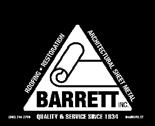









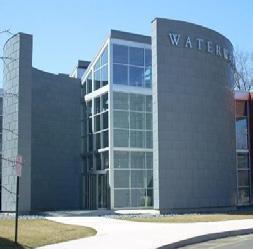



We all know the difficulties faced by contractors who attempt to recover delay damages from an owner or construction manager, especially in the face of a tightly worded “no damage for delay clause.”
Unfortunately, this often includes situations where the delay to the project’s schedule lies squarely at the feet of a third-party, i.e., another contractor, supplier or design professional.
In such cases, seeking recourse from the offending third-party might seem like a viable option, but it is rarely that straightforward.
This was the case for Greg Beeche, Logistics, LLC (Beeche) [1], a scaffolding contractor hired by a construction manager at risk on a high-rise project in New York City. The defendant in this action provided the concrete superstructure and, through alleged misconduct, negligence, and misrepresentation, delayed the project by almost two years. Beeche, who was hired to install and maintain a custom scaffolding system for the duration of the project, was forced to leave the scaffolding in place during this delay and lost out on millions of dollars in rentals. Presumably faced

with a no damage for delay clause in its agreement with the CM, Beeche attempted to recover damages from the concrete contractor on the basis that it was a third-party beneficiary to the construction manager-defendant trade contract.
Unfortunately for Beeche, the trial and appellate courts rejected its claim. In New York, a contractor is only considered a third-party beneficiary of a contract if they can demonstrate that the contract was intended for their benefit. [2] In this case, the CM-Concrete trade contract did not “expressly designate” Beeche as a beneficiary, which ultimately left it without recourse for the delay damages caused by the defendant.
So what are the key takeaways for contractors in similar situations?
1. First, never assume that delays by other trades are not your problem. While some agreements provide for the ability to seek equitable adjustment for such delays, many limit the adjustment to an extension of time only and further require specific, detailed and timely written notice.
2. Pay attention to prime agreements that attempt to place the obligation of trade coordination and sequencing onto the trades
themselves. This can lead to forced acceleration, out-of-sequence work, inefficient means and methods, and overtime, all in an effort to catch up to the critical path method (CPM).
Contractors may find it difficult to recoup even the direct costs of these expenditures unless they negotiate revisions to such clauses prior to contract execution.
3. When bidding on a project, be mindful of the trades with whom you’ll be working side by side or who will be in charge of predecessor scope work. Their delays will impact your commencement, sequencing, and completion.
If these trades are unknown entities or have a reputation for causing problems, contractors should reflect this in their bid number.
[1] Greg Beeche, Logistics, LLC v. Cross Country Construction, LLC, 210 A.D.3d 1158, 178 N.Y.S.3d 231 (3d Dept. 2022)
[2] Port Chester Elec. Construction Corp. v. Atlas, 40 N.Y.2d 652, 655, 389 N.Y.S.2d 327, 357 N.E.2d 983, 986 (1976)
mobile device.
The Construction Contractors Association of the Hudson Valleyis grateful to our Diamond Sponsors* for their exceptionally generous commitment to the CCA and the work we do on behalf of our members, our industry, and our partners in the building trades:
AFFINITY BST ADVISORS
BEAM ENTERPRISES, INC.
BARONE CONSTRUCTION GROUP, INC.

HOLT CONSTRUCTION CORP.
IRONWORKERS LOCAL 417
INTERNATIONAL UNION OF OPERATING ENGINEERS LOCAL 137
LABORERS’ INTERNATIONAL UNION OF NORTH AMERICA LOCAL 235
MDS HVAC-R, INC.
MARSHALL AND STERLING, INC.
M&T BANK
Michael Chrys, CIMA®
Managing Director
Wealth Management Advisor
518.782.4094
michael_chrys@ml.com
26 Century Hill Drive Latham, NY 12110
fa.ml.com/chrysgroup
NORTH ATLANTIC STATES REGIONAL COUNCIL OF CARPENTERS LOCAL 279
PARAMOUNT BUILDING CONSTRUCTION, INC.
PERRECA ELECTRIC, INC.
SERVICE SCAFFOLD COMPANY, INC.
TECTONIC ENGINEERING CONSULTANTS, GEOLOGISTS, & LAND SURVEYORS
TRI-STATE DRYWALL AND ACOUSTICAL, INC.
Merrill Lynch, Pierce, Fenner & Smith Incorporated (also referred to as “MLPF&S” or “Merrill”) makes available certain investment products sponsored, managed, distributed or provided by companies that are affiliates of Bank of America Corporation (“BofA Corp.”). MLPF&S is a registered broker-dealer, registered investment adviser, Member SIPC and a wholly owned subsidiary of BofA Corp. Investment products:
The Bull Symbol and Merrill are registered trademarks of Bank of America Corporation. CIMA® is a registered certification mark of the Investments & Wealth Institute®. For more information about the Institute and the CIMA certification, please visit investmentsandwealth.org.
© 2022 Bank of America Corporation. All rights reserved.
MAP4264780 | AD-11-22-0282 | 470944PM-0222 | 11/2022
*DIAMOND SPONSORS AS OF MARCH 31, 2023
CCA Diamond Sponsors enjoy all networking, educational, and promotional opportunities, including: One year membership to the CCA, SMACNA or FERCA; four full page ads in On the Level; guaranteed foursome and prominent signage at the CCA Golf Outing; and two tickets to the Lobster Bake, Annual Dinner Meeting, and Holiday Get-Together. Diamond Sponsorship is $4999, a $1300 savings if all benefits are purchased separately. For more information call the CCA office at 845-562-4280.
Cele
Guided by a desire to provide excellent and comprehensive legal representation, the attorneys at Catania, Mahon & Rider, PLLC offer strategic and cost-efficient solutions to businesses and their owners.

• Acquisitions, Sales and Mergers
• Business Succession Planning and Estate Planning
• Shareholder, Partnership and Operating Agreements


• Commercial Transactions, Leasing and Financing
• Business Breakups
• Employment Law and Regulatory Compliance
Michelle Rider mrider@cmrlaw.com

• Trademarks and Copyrights
• Corporate Governance
CONSTRUCTION SERVICES
Contract Drafting, Negotiation and Review
• AIA, Consensus Docs, EJCDC, State/Agency Specific Insurance Review (IRMI Certified) Construction Dispute Resolution
• Payment Disputes/Delay Damages
• Wrongful Termination
• Mechanics Liens and Payment Bond Claims
MWBE/DBE
• Certification and Compliance
mcatania@cmrlaw.com

Many CFOs are reluctant to get involved in the supply chain management process, leaving that area to the COO and their team of experts. But in the current environment, it should be all-handson-deck as businesses continue to grapple with supply chain disruption and the uncertainty it brings to the entire company.
Best practices for a manufacturer are different than those for a distributor, and both are different than those for a retailer. The challenge of finding the right best practices is that many manufacturing businesses now overlap all three categories. In today’s world of migration away from brick-andmortar shops, the online fulfillment process places many companies in the position of operating as manufacturer, distributor and retailer.
This migration, combined with the rollercoaster of on-again, off-again demand caused by COVID and post-COVID environments, leaves supply chains snarled. The shift toward flexible work-from-home arrangements further complicates the issue, straining every function and process in an organization.
Fortunately, there are best practices in risk management that can help any CFO better support the supply chain management process.
Risk management for a CFO takes on new challenges in this ever-changing environment. Internal controls, remote procedures and the need for accurate forecasts, all force a CFO to reach beyond the normal four walls of the company to manage supply chain relationships and soften the blow caused by the pendulum of swing of demand.
Visibility into “sell-through” data is essential for manufacturers to navigate these changes. Best practices would have companies monitoring everything from customer inventory and supply availability to scheduled delivery dates from critical suppliers.
Key performance indicators (KPIs) throughout an organization take on new meaning in this context. At a minimum, make sure you are tracking forecast accuracy, on-time delivery, unit throughput, average days in work in process, yield, scrap, order fulfillment rates, workstation efficiency and lead times. In this environment, a yield loss on one manufactured part can hold up an entire shipment – just look at the impact of semiconductor availability on the auto industry.
This data combined with another best practice – communicating and working with customers and distributors to
modulate inventory levels – enables a company to proactively mitigate as much risk as possible.
Evaluating internal controls is an essential best practice in any economy, but especially in today’s risky environment. Remote workforces and reduced headcount leave companies especially vulnerable to gaps in supply management controls. Everything from an initial requisition to the positive pay upload and bank reconciliation need to be executed with a proper segregation of duties within a system of KPIs. The CFO needs to elevate visibility into internal control operation from a background process to a monitored system.
In remote work environments, Zoom and Microsoft Teams meetings are typically focused on a limited number of issues. The visibility into the connection between various supply chain issues becomes blurred. Critical KPIs and vigilant controls are the guide rails that keep these connections at the forefront and create a clearer roadmap to delivering exceptional value to customers.
Anthony D’Agostino Consulting Principal Grassi’s Manufacturing and Distribution
We get it. You are busy writing bids, securing contracts, managing projects, and dealing with personnel issues all day long. But when do you get to plan for your own financial tomorrow and still live for today?

We’ll help you plan to do the things you live for. Whether you are imagining a retirement sailing around the world or just kicking back with your family, we can tailor a plan from a wide range of financial options to make it happen. Our team of financial planning advisors can help identify your financial planning goals and address those needs with investment strategies for potential growth. With the full suite of Northwestern Mutual resources at our fingertips, we also assist business owners in developing succession and estate plans to protect the continuity of their life’s work and position it to flourish in the future.
Patrick A Di Cerbo, CLU®, ChFC®, AEP®, MSFS, CFP® Wealth Management Advisor 518.281.8200 patdicerbo.com pat.dicerbo@nm.com07-1016 © 2021 Northwestern Mutual is the marketing name for The Northwestern Mutual Life Insurance Company (NM), (life and disability insurance, annuities, and life insurance with longterm care benefits) and its subsidiaries in Milwaukee, WI. Northwestern Mutual Investment Services, LLC (NMIS) (securities), a subsidiary of NM, broker-dealer, registered investment adviser and member FINRA and SIPC. Patrick A Di Cerbo is an Insurance Agent(s) of NM. Patrick A Di Cerbo, is a Registered Representative(s) of NMIS. Patrick A Di Cerbo, is a Representative of Northwestern Mutual Wealth Management Company®, (NMWMC) (fiduciary and fee-based financial planning services), a subsidiary of NM and federal savings bank. All NMWMC products and services are offered only by properly credentialed Representatives who operate from agency offices of NMWMC. Certified Financial Planner Board of Standards Inc. owns the certification marks CFP®, CERTIFIED FINANCIAL PLANNER™ and CFP® (with flame design) in the U.S., which it awards to individuals who successfully complete CFP Board’s initial and ongoing certification requirements.







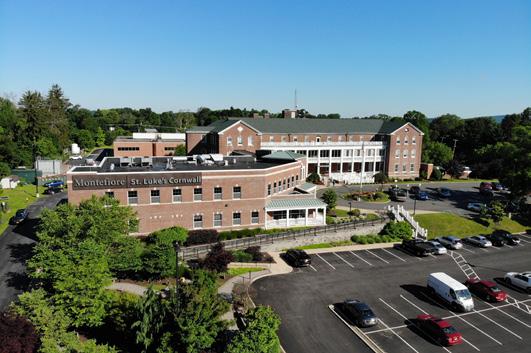
Stories of bad customer service abound. How many times have you gotten off the phone shaking your head after dealing with the cable company? How about the washing machine repairman who never shows—after you took the day off from work to wait for him? What about the hours spent waiting on hold for a customer service agent to help you with a problem only to have the call disconnect?
For service industries, poor customer service can be a death knell that drives even longtime customers to the competition. Sadly, the business owner may never know the customer is unhappy until it’s too late. Negative online reviews make it hard for a company to overcome a poor reputation.

On the other hand, excellent customer service can not only retain customers but can
attract new ones too. Word of mouth from satisfied customers is one of the best business development tools available and it’s free.
When there is no tangible product to sell—if a customer can’t see it, hold it, or try it out— good customer service becomes dependent on employees with high level people skills. They must be laser-focused on customer satisfaction, building rapport and becoming a trusted company source. Pricing becomes less of an issue (as long as the price is within market expectations). Relationships are what keeps service companies in business.
The key is hiring and retaining the right staff. A positive outlook and the ability to relate to your customers is paramount. Even a job candidate with the right personality but little market experience can be trained to deliver an outstanding customer experience.
 Robin Seidman specializes in general HR policy and procedures. rseidman@ccahv.com
Robin Seidman specializes in general HR policy and procedures. rseidman@ccahv.com
On the flip side, hiring a “body” to fill an opening can have devastating results. The employee who views the position as a job to pay the bills and has little interest in the success of your business or your customers is not someone you want interacting with your clients. If customer service is not in the DNA - the employee is probably not trainable.
Which leads us to customer service training. Before the business owner even thinks about how to train, they should have a customer service philosophy. The grocer, Stew Leonard’s, has two rules for customer service that are non-negotiable:
● Rule No. 1: The customer is always right
● Rule No. 2: If the customer is ever wrong, re-read Rule No. 1
Now, that is extreme for a service industry but it explains why Stew Leonard’s is one of the most successful stores in the Northeast.
• Address all customers by name at least once during a conversation, whether on the phone or in person.
• Answer all phone calls by the third ring.
• Use a standard phone answering message that includes the employee’s name. For example, “Good morning, ABC Company, this is Robin speaking. How may I help you?”
• Don’t strive to meet the expectations, strive to exceed the customer’s expectations. All that takes is the extra step—the one that your competitors are missing.
• Deliver on your promises. If your employees say they will get back to a customer, make sure they do that before going home. Even if there is nothing new to report. A call that updates the customer - even if it’s to say “I don’t have an answer yet” - goes a long way to developing a trusting relationship with a customer.
• Lead by example. If you don’t follow the standards, why would your employees?
Training does not have to be burdensome. Make sure your job candidates know what your standards are before a job offer is made. Gauge their responses to make sure they are a good fit for your business. At orientation, the business owner should deliver the standards in writing to the new hire to emphasize the importance of customer service. Have the employee train with your best customer service team member. Observing and asking questions is the best way for a new hire to “get” how they should interact.
• Watch and listen to your employees during customer interactions. Praise them when it’s a great job. Coach them if they miss a step.
• Let them blow off steam - in private. Customers can be difficult and frustrating. They can be stressful to deal with. Give your employee a break to go into the break room or outside where they can decompress.That ensures that the next customer doesn’t feel the brunt of the employee’s rage.
• Start an Employee of the Month campaign. Based on your observations or customer comments or compliments, reward outstanding service. Tie a perk to the reward - a Friday off, a dinner certificate, a picture on the wall where everyone, customers included, can see it. If nobody qualifies for the reward in a month, don’t just pick someone with ho-hum service. Remember, you are rewarding your team for exceeding customer expectations, not meeting them.
• Personally handle the abusive customers (we all know they’re out there). Sometimes, you may even have to fire a client because they are just so unreasonably demanding and demeaning to your team. Your employees will appreciate that you have their backs.
• Become the role model for excellent customer service. Make it a part of everyone’s day, like punching a time clock.
Once your team gets into the rhythm of delivering outstanding customer service your business should bloom with repeat business from your satisfied customers and employees who are engaged in your everyday operations. A win-win for all!

From changing a lightbulb to getting on a roof, ladders are a common piece of equipment used in almost every home and job site. They may appear harmless, but working on and around ladders is hazardous.
Ladders are major sources of injuries and fatalities among construction workers - and many of the injuries are serious enough to require time off the job. In fact, about every year, 100 people die in ladder related accidents and thousands more suffer disabling injuries.
The good news is that ladder safety is becoming a key safety topic among employees in the construction industry and ladder-related injuries and fatalities are completely preventable. Understanding safe practices and the different types of ladders are key, and OSHA offers these helpful tips:
● Read and follow all labels and markings on the ladder.
● Avoid electrical hazards. Look for overhead power lines before handling a ladder and avoid using metal ladders near power lines or exposed energized electrical equipment.
● Inspect the ladder prior to use. If damaged it must be removed
from service and tagged until repaired or discarded.
● Maintain three-point contact (two hands and a foot, or two feet and a hand) while climbing. Keep your body near the middle of the step and face the ladder while climbing.
● Only use ladders and appropriate accessories (levelers, jacks or hooks) for their designed purposes.
● Ladders must be free of slippery material on the rungs, steps or feet.
● Do not use a self-supporting ladder (e.g., step ladder) as a single ladder or in a partially closed position.
● Do not use the top rung unless designed for that purpose.
● Use ladders on a stable and level surface, unless it has been properly secured.
● Never place a ladder on boxes, barrels or any unstable base to obtain additional height.
● Do not move or shift a ladder while a person or equipment is on the ladder.
● An extension or straight ladder used to access an elevated surface must extend at least 3 feet above the point of support.
● Do not stand on the three top rungs of a straight, single or extension ladder.
● The proper angle for setting up a ladder is to place its base a quarter of the ladder’s working length from the wall or other vertical surface.
● In any location where a ladder can be displaced by other work activities must be secured or a barricade erected to keep traffic away.
● Check that all locks on an extension ladder are properly engaged.
● Do not exceed the maximum load rating of a ladder. Be aware of its load rating and of the weight it is supporting, including the weight of any tools or equipment.
Ladders must be inspected periodically for defects and damage and always after any occurrence that could affect their safe use.


Before each use, inspect for:
• Broken split, cracked, corroded or missing rungs and side rails
• Cracks, which can be hard to see and weaken ladders.
• Excessive bends. Bent rungs and side rails are weakened and may fail.
• Loose, corroded, or weakened fasteners and hardware
• Missing or damaged feet
• Defects hidden by paint or coating
• Oil, grease, and other slipping hazards
• The capacity label, and that the ladder will safely hold you and everything you’re wearing and carrying
CCA members are among the most generous folks around. They’re committed to their communities, and no matter how busy things get they’re volunteering, fundraising, and finding all kinds of wonderful ways to give back.


We’d love to shine a light on these good deeds. If your organization or someone within it is out making the world a bit brighter, please tell us about it so we can include it in “On the Level.”
Whether they’re coaching a local team, serving as a volunteer first responder, collecting supplies for a shelter, or giving their time and skills to worthy effort, we want to know.


We can’t wait to share these inspiring stories with our On the Level readers!
845-562-4280
LRamirez@CCAHV.com CCAHV.com

330 Meadow Avenue
Newburgh, NY 12550

ABM Air Conditioning
Advance Testing Company, Inc.
Advanced Disaster Recovery, Inc.
Affinity BST Advisors, LLC
Alfandre Architecture, P.C.
All Bright Electric
AMX Contracting Corp.
Andron Construction Corp.
Antalek & Moore Insurance Agency
Argenio Brothers, Inc.
Armistead Mechanical, Inc.
Atlas Security Services
B. Miller Masonry, Inc.
Barone Construction Group, Inc.
Barrett Sheet Metal
Basec Corp.
Beam Enterprises, Inc.
Blue Eagle Security, Inc.
BNY Mellon
The Bonadio Group
Broadfield Group, LLC
BST & Co.CPAs, LLP
Butler Construction Group, Inc.
C.B. Strain & Co. (A division of Dynamic Systems)
Callanan Industries, Inc.
Carey & Walsh
Casler Masonry, Inc.
Catania, Mahn & Rider, PLLC
Central Hudson Gas & Electric Corp.
Clean Air Quality Service, Inc.
CohnReznick, LLP
Colliers Engineering & Design CT, P.C.
Con-Tech Construction Technology, Inc.
Couch White, LLP
Council of Industry of Southeastern New York
CSG Partners - ESOP Advisory
Custom Exterior Systems
D & G Electrical Supply Co., Inc
D.A. Collins Construction Co., Inc.
D.L. Flow Tech
Darlind Associates, Inc.
DeBrino Caulking Associates
Delaware Engineering
Ductmate Industries
Durante Rental
Dutchess County Regional Chamber of Commerce
E-J Electric Installation Co.
ECCO III Enterprises, Inc.
EMF Technical Services, Inc.
Enviro-Clean
F & F Mechanical
Fairway Testing Co., Inc.
Federated Mutual Insurance Company
Fischer Group at Graystone Consulting | Morgan Stanley
Ferrari & Sons, Inc.
Gillespie Real Estate LLC
Grassi & Co. CPAs
H.T. Lyons Inc.
Halmar International, LLC
Harden Sheet Metal, Inc.
Hauser Bros., Inc.
Helmer-Cronin Construction
Herzog’s Home & Paint Center
Hesnor Engineering Associates
Holt Construction Corp.
Howard Hanna Realty
Hudson Valley Pattern For Progress
iSER Consulting, LLC
J & M Heating & AC, Inc.
James McGowan & Son Masonry, Inc.
Jett Industries, Inc.
John W. Danforth Company
KCM Contracting Inc.
Key Construction Services
Keystone Management Associates, LLC
LeChase Construction Services
Liberty Mutual
Link Metal Finishing Corp.
Liscum, McCormack & Van Voorhis, LLP
Lovell Safety Management Co.
M & T Bank
Marshall & Sterling
Matrix Asset Advisors, Inc.
McGoey, Hauser & Edsall Consulting Engineers
MDS HVAC-R, Inc.
Merrill Lynch
Milliman, Inc.
Minuta Architecture PLLC
Modernfold/Styles
Montana Data
Nadoka Luxury Cleaning
New Beginnings Window & Door
Nexgen Protection Services LLC
Northwestern Mutual
NXG Insurance Group
O’Kane Enterprises, Ltd.
Olori Crane Service, Inc.
Orange & Rockland Utilities
Orange Bank & Trust
Orange County Chamber of Commerce
Orange County Ironworks LLC
PCC Contracting, Inc.
Pagones-O’Neill Investigations and Security, Inc.
Paramount Building Construction, Inc.
Partner Equipment Rental
Pearl River Sheet Metal
Penlyn Construction Corporation
Perfezione Painting, Inc.
Perreca Electric, Inc.
The Pike Company
Pittman & Brown, Inc.
PKF O’Connor Davies, LLP
Price and Price Enterprises, Inc. (DBA Melwain Surety Bonds)
Profex, Inc.
RAL Supply Company
Raritan Group, Inc.
Ray S. Pantel, Inc.
RBT CPAs
Rhinebeck Bank
Rider, Weiner & Frankel, P.C.
Riverside Bank
RKB Sheet Metal
Rockland Business Association
Rover Contracting, Inc.
Schultheis & Panettieri, LLP
Schumacher Systems, Inc.
Service Scaffold Company, Inc.
Stacey Braun Associates, Inc.
Steven A. Scala, CPA, P.C.
Sullivan Construction Group, LLC
Sullivan County Partnership for Economic Development
Sullivan Fire Protection Corp.
TDX Construction Corporation
Taconic Heating & Cooling
Taylor Recycling Facility, LLC
Tectonic Engineering Consultants, Geologists & Land Surveyors, DPC
Thomas J. Kempton, Jr., Inc.
Tri Co Electric of Goshen, LLC
Tri State Associated Services, Inc.
Tri-State Drywall & Acoustical, Inc.
Turner Mechanical Service
U.S. Test & Balance Corp.
USI Insurance Services
U.W. Marx Construction Company
Ulster Savings Bank
United Rentals
United Spray LLC
Upstate Electrical, LLC
Walden Savings Bank
Wallkill Valley Federal Savings & Loan Association
Welby, Brady & Greenblatt, LLP
World Insurance Associates, LLC
Membership as of March 31, 2023
Since 1956, the Construction Contractors Association of the Hudson Valley has had a hand in almost every significant construction project in the region. With a commitment to providing quality management coupled with outstanding workmanship, CCA members get jobs done right, on time and within budget.


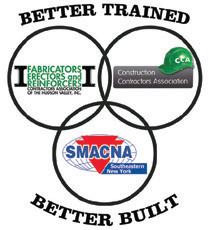

• The power and leverage of strong relationships with state, local and federal officials

• Project leads
• Exclusive networking and informational opportunities
• Access to the CCA directory of contractors, suppliers and service providers
• The support of the CCA staff
• The money saving support of the CCA’s labor expertise regarding compliance, wage and fringe issues, and grievances
• Competitive health insurance plans with premium rates not available in the open market
• Retirement planning
